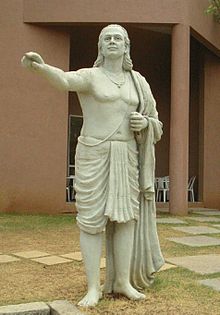Āryabhaṭa
| Āryabhaṭa | |
|---|---|

|
|
| Born | 476 CE Kusumapura (Pataliputra) (present day Patna |
| Died | 550 CE |
| Residence | India |
| Academic background | |
| Influences | Surya Siddhanta |
| Academic work | |
| Era | Gupta era |
| Main interests | Mathematics, astronomy |
| Notable works | Āryabhaṭīya, Arya-siddhanta |
| Notable ideas | Explanation of lunar eclipse and solar eclipse, rotation of Earth on its axis, reflection of light by moon, sinusoidal functions, solution of single variable quadratic equation, value of π correct to 4 decimal places, circumference of Earth to 99.8% accuracy, calculation of the length of sidereal year |
| Influenced | Lalla, Bhaskara I, Brahmagupta, Varahamihira |
Aryabhata (Sanskrit: आर्यभट; IAST: Āryabhaṭa) or Aryabhata I (476–550 CE) was the first of the major mathematician-astronomers from the classical age of Indian mathematics and Indian astronomy. His works include the Āryabhaṭīya (499 CE, when he was 23 years old) and the Arya-siddhanta.
While there is a tendency to misspell his name as "Aryabhatta" by analogy with other names having the "bhatta" suffix, his name is properly spelled Aryabhata: every astronomical text spells his name thus, including Brahmagupta's references to him "in more than a hundred places by name". Furthermore, in most instances "Aryabhatta" would not fit the metre either.
Aryabhata mentions in the Aryabhatiya that it was composed 3,600 years into the Kali Yuga, when he was 23 years old. This corresponds to 499 CE, and implies that he was born in 476. Aryabhata called himself a native of Kusumapura or Pataliputra (present day Patna).
Bhāskara I describes Aryabhata as āśmakīya, "one belonging to the Aśmaka country." During the Buddha's time, a branch of the Aśmaka people settled in the region between the Narmada and Godavari rivers in central India.
It has been claimed that the aśmaka (Sanskrit for "stone") where Aryabhata originated may be the present day Kodungallur which was the historical capital city of Thiruvanchikkulam of ancient Kerala. This is based on the belief that Koṭuṅṅallūr was earlier known as Koṭum-Kal-l-ūr ("city of hard stones"); however, old records show that the city was actually Koṭum-kol-ūr ("city of strict governance"). Similarly, the fact that several commentaries on the Aryabhatiya have come from Kerala has been used to suggest that it was Aryabhata's main place of life and activity; however, many commentaries have come from outside Kerala, and the Aryasiddhanta was completely unknown in Kerala. K. Chandra Hari has argued for the Kerala hypothesis on the basis of astronomical evidence.
...
Wikipedia
